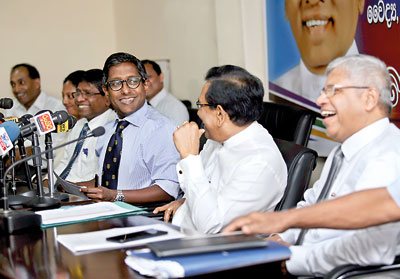News
Govt. sharply cuts prices of costly lenses used for cataract surgery

A moment of banter during the media briefing. From the right are Health Ministry Secretary Anura Jayawickrama; Health Minister Dr. Rajitha Senaratne; NMRA Head Prof. Asita de Silva; Acting Director-General of Health Services Dr. Jayasundara Bandara; College of Ophthalmologists President Dr. Madhuwanthi Dissanayake; Consultant Ophthalmologist Dr. Charith Fonseka and (in the second row) College of Ophthalmologists Secretary Dr. Kusum Ratnayake. Pic by Anuradha Bandara
Months after reducing the prices of several essential drugs, the Government on Friday sharply cut the prices of costly lenses used as implants during cataract surgery and said it was eyeing another expensive but inevitable option in patient care – private hospitals and laboratories.
The prices of 38 common varieties of intra-ocular lenses implanted during cataract surgery have been regulated by the government with effect from Friday night, reducing some of them by as much as 77 %.
The maximum retail price (MRP) of these acrylic foldable intraocular lenses were announced in Extraordinary Gazette 2006/45 of February 17 under the ‘Ministry of Health – The National Medicines Regulatory Authority Act No. 05 of 2015 and the Medical Devices Pricing Regulations No. 01 of 2017 (Intraocular Lenses with Delivery System)’.
The regulatory prices for the most commonly-used intraocular lenses in the country had been decided by the National Medicines Regulatory Authority (NMRA) under the guidance of Health Minister Dr. Rajitha Senaratne, after extensive discussions with the College of Ophthalmologists of Sri Lanka and the companies importing these devices.
The MRP covers not only the acrylic foldable intraocular lens but also the injector used to implant the lens by Ophthalmologists or Eye Surgeons. The price reduction brought about by the MRP ranges from 37% to 77%, the Sunday Times learns.
“The exorbitant amount of money spent by people on intraocular devices came to my notice during a chat with two retired Directors-General of Health Services at a medical meeting recently,” Minister Senaratne told a media briefing on Friday at the Health Ministry, explaining that he was shocked to hear that one had paid Rs. 400,000 and the other Rs. 326,000 for the lens and the surgery for both eyes, respectively.
Pointing out that “health should not be a business”, he said that they had brought down the prices of 48 essential medicines in September last year and now imposed an MRP on 38 types of intraocular lenses.
The Minister’s next ‘targets’ will be stents used in heart procedures and the exorbitant costs faced by patients at private hospitals and laboratories. What should be remembered is that health is a service and even in the private sector even though there could be reasonable profits there should not be corruption, he said.
These price-regulated intraocular lenses will be in the market, while all the lenses necessary for patients undergoing cataract operations in state hospitals is now being provided free of charge by the government. The Sunday Times learns that nearly 90,000 cataract operations are performed every year in state hospitals, with Minister Senaratne stating that the government has stocks of 100,000 intraocular lenses ready to meet this demand.
Whenever a new system is implemented there will be a few issues initially, but these get smoothened out, the Minister said.
Explaining how the pricing structure was worked out, NMRA Chairman Prof. Asita de Silva said that the drug prices were brought down after studying the island-wide pricing data for drugs and their market share gathered by IMS (Islandwide Marketing Services Pvt Ltd.). There was no such basis on which they could look at intraocular lenses. Therefore, he and NMRA’s Pricing Committee Head Dr. Palitha Abeykoon looked at the CIF (Cost, Insurance and Freight) value.
What they found was that even though the CIF value varied, depending from which country the intraocular lenses are imported, the patients were charged high prices, with the mark-up sometimes being 400%.
“This was while the government was not charging taxes or a port levy. But these benefits were not being passed on to the patients,” said Prof. de Silva.
Thereafter three meetings were held with the Sri Lanka Chamber of Medical Devices Industry which also wanted the regulated prices gazetted soon.
Pointing out that the MRP is only for the commonly-used intraocular lenses, Prof. de Silva said that the prices of certain lenses which are brought for patients with special needs have not been regulated. They include multi-focal lenses and toric lenses for serious astigmatism brought into the country on a needs-basis.
The President of the College of Ophthalmologists, Dr. Madhuwanthi Dissanayake said that earlier some patients were buying poor quality intraocular lenses which created problems and as such this price-regulatory measure by the government would help quality lenses to be bought at reasonable prices. The second commendable measure is the provision of quality intraocular lenses free of charge at state hospitals for patients who undergo cataract surgery there, with an assurance from the Minister that facilities for their implantation would also be provided.
Respected Consultant Ophthalmologist Dr. Charith Fonseka described how they set about regulating the prices of these intraocular lenses. “We categorized the lenses of different brands according to the material used to manufacture them. We discussed the issues that arose and also the specific standards needed for these lenses.”
Explaining that prices of lenses commonly used by people have been regulated, the Secretary of the College of Ophthalmologists, Dr. Kusum Ratnayake said that particular lenses needed by patients who may have special needs are available in the market and have not been price-regulated.

